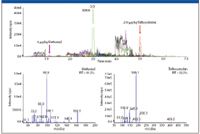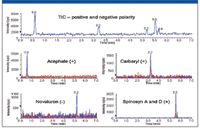A New Perspective on the Challenges of Mass Spectrometry
Special Issues
The authors discuss the challenges presented by the many new applications of mass spectrometry.
Laboratories embroiled in the intricacies of drug discovery and development, proteomics, and food and water testing are becoming increasingly dependent upon sophisticated mass spectrometers to overcome the significant and limiting challenges they face. Problems such as sample type, quality, and concentration, ever-increasing throughput demands, and limitations of currently available mass spectrometry workflows are all a matter of course and must be dealt with to push the boundaries of analysis even further.
For drug discovery workflows, the issue of metabolite detection and identification in in vivo systems is a critical challenge. The wide range of complex matrices (such as bile, plasma, urine, and fecal extracts), and the ion suppression effects of these biological fluids, can cause a severe decrease in the ability to detect metabolites. Greater instrument sensitivity is necessary to detect these compounds and, at the same time, helps to minimize sample preparation, simply diluting the negative effects of these complex matrices and avoiding the time- and labor-consuming sample cleanup or concentration steps that otherwise might be required.
In drug development, microdosing (using less than one hundredth of the normal dose) studies allow earlier, and potentially safer, assessment of the pharmacokinetics of new compounds in humans compared to conventional Phase I trials, as well as to reduce or replace safety and toxicology testing in animals. The high sensitivity of liquid chromatography–mass spectrometry (LC–MS) is a significant factor in such strategies, allowing the detection of much lower concentrations of compounds and metabolites in both quantitative and qualitative work.
Many of the compounds of interest occur in low levels, a familiar issue in biomarker verification and validation work too, and insufficient instrument sensitivity could lead to the failure to detect key compounds. In the food and environmental industries also, quality control processes constantly demand greater sensitivity to keep apace with legislative regulations that progressively reduce acceptable limits of an increasing number of contaminants. With the large number of compounds that must be detected, less time is available to monitor each compound within a run, resulting in poor sensitivity and often leading to multiple injections, adding considerable time to experiments. Improved instrument sensitivity and scan speed would allow many more analytes to be monitored in the same run at the required sensitivity so that fewer injections would be required per experiment, thereby offering the potential to obtain all the necessary answers in a single injection. The speed of the mass spectrometer is also important in other ways. With the current trend for faster chromatographic analysis times of 5 min or less, a system must be capable of yielding sufficient data points from each chromatographic peak for effective LC–MS analysis. In addition, faster scanning and improved duty cycle enable more efficient automated workflows.
New Realms of Flexibility
For the identification of a large number of compounds (for example, in the pharmaceutical discovery phase), a first pass traditionally has been performed with a triple-quadrupole mass spectrometer for the selective scan functions, like precursor ions and neutral loss, helping to filter out unwanted compounds. In general, the selective nature of multiple reaction monitoring (MRM), precursor ion, and neutral loss scans provides the highest level of detection compared to any single MS-based methodology. Then, for confirmation, other instruments like ion traps were used to obtain high quality MS-MS spectra.
Now, with a drive for greater quality, efficiency, throughput, and confidence in data using as few injections as possible, mass spectrometers are being designed to meet scientists' needs precisely. Instruments with improved sensitivity, speed, and selectivity, coupled with unique combinations of technologies within a single platform to enable more efficient workflows, are being developed by leading manufacturers. Hybrid instruments include Applied Biosystems/MDS Analytical Technologies' AB SCIEX QTRAP 5500 System, which combine a triple quadrupole and a linear accelerator trap on the same platform. Such instruments are changing the way MS analysis, like metabolite identification, is performed (for example, predictive MRM [pMRM], coupled with full-scan MS-MS in the same analysis to confirm that the compound is the expected metabolite). The hybrid nature also allows more than one test to be performed in one run, which is ideal for applications such as testing for pesticides and mycotoxins in grain-derived food products, and screening for pharmaceuticals and personal care products (PPCP) in drinking water.
With the addition of a newly developed ion guide and improved Q3 LIT, the latest of these systems shows great increases in signal response, particularly in LIT mode. Duty cycle is improved further with trap fill times as short at 50 μs, because of the increase in linear accelerator trap sensitivity. We are also seeing scan rates up to 20,000 Da/s in linear accelerator trap mode and four times faster in quadrupole mode compared to previous systems. This greater cycle rate allows for compatibility with sharp chromatographic peaks, as well as improved information-dependent acquisition (IDA) coverage provided by a greater number of MS-MS-dependent scans, a great advantage when complex matrices, such as bile, contain a notable number of nonmetabolite peaks and may cause extraneous IDA triggers. The improvements in triple-quadrupole scanning rates also allow multiple survey scans, and simultaneously trigger full-scan MS-MS from any peaks that might be present using LIT. The greater speed of the newest instruments, which can detect more than 1000 compounds, means that they are ideal for multitarget analysis, detecting all compounds of interest in just one injection (Figure 1).

Figure 1: Analysis of grape samples for more than 1000 pesticides. Methomyl and trifloxystrobin were quantified and identified using scheduled MRM and fast MS-MS library searching.
With polarity switching as fast as 50 ms, it is possible to combine the most powerful modes of metabolite detection in a single injection workflow with sufficient sensitivity in an overall duty cycle time of around 2 s, for an accurate result in comprehensive detection of metabolites (Figure 2) and pesticides (Figure 3).

Figure 2: Detection of simvastatin hydroxyl acid in both positive and negative ion. The lactone prodrug simvastatin is hydrolyzed to the active compound (simvastatin hydroxyl acid), and both simvastatin and the hydroxyl acid ionize in positive ion, but the hydroxyl acid is better detected in negative ion. Of the 34 metabolites, five were detected only in positive ion, 28 detected only in negative ion, and one (Mx) was detected in both polarities.
The improved sensitivity and speed are also important factors for efficient targeted peptide quantitation workflows, including biomarker verification and validation, and the high selectivity for compounds of interest certainly increases the throughput of automated workflows. The newer combined systems enable hypothesis-driven verifications, removing the need for synthetic protein standards in assay development, and the heightened sensitivity enables the linear accelerator trap to match the sensitivity of the MRM, speeding up development and identification confirmation. Scheduled MRM enables much higher multiplexed assays while still maintaining analytical reproducibility; with the latest instruments capable of up to 2500 MRMs in a single run, equating to 100 proteins, a single run is enough to obtain all the data required, eliminating what was previously a potential bottleneck.

Figure 3: Ultrafast LCâMS-MS analysis of four pesticides in drinking water at 0.1 mg/L using fast polarity switching and fast MRM detection.
Dealing with the Increase in Data
The latest software programs that accompany MS platforms have been developed to bring all the sophisticated, complex methods right to the researcher's fingertips, with just a few clicks of the mouse. User-friendliness is a key feature, helping to make MS technology accessible to many more users. Ready-to-use, preconfigured protocols and experiments are especially helpful to those who are new to LC–MS, and allow them to be running meaningful experiments within weeks, rather than months.
Data analysis software similarly has been upgraded to handle the huge amounts of data resulting from the greater throughput of new MS instruments, streamlining and automating the analysis process to require minimal manual intervention.
The new systems offer a complete solution for LC–MS-MS workflows in various applications, with the best of both quantitative and qualitative accuracy and reproducibility, as well as generating superior targeted quantitative analysis, validation, and confirmation in a single run.
Gary Impey, Christie Hunter, and Andre Schreiber are with Applied Biosystems, Inc., Foster City, California.

Mass Spectrometry for Forensic Analysis: An Interview with Glen Jackson
November 27th 2024As part of “The Future of Forensic Analysis” content series, Spectroscopy sat down with Glen P. Jackson of West Virginia University to talk about the historical development of mass spectrometry in forensic analysis.
Detecting Cancer Biomarkers in Canines: An Interview with Landulfo Silveira Jr.
November 5th 2024Spectroscopy sat down with Landulfo Silveira Jr. of Universidade Anhembi Morumbi-UAM and Center for Innovation, Technology and Education-CITÉ (São Paulo, Brazil) to talk about his team’s latest research using Raman spectroscopy to detect biomarkers of cancer in canine sera.